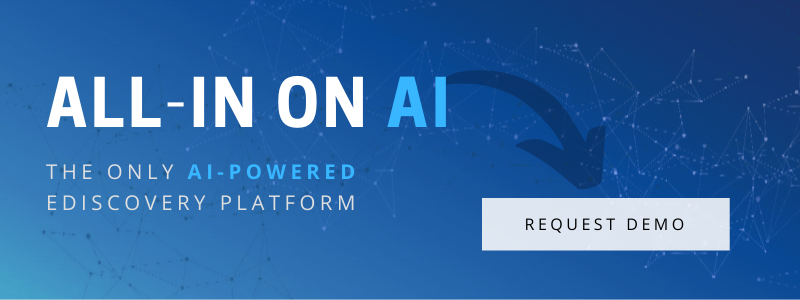Clearing Production Hurdles in eDiscovery
Whether it is a last minute addition of 10 custodian’s data, weird data formats or simply ever - shrinking deadlines, productions come at practitioners with a whole host of potential hurdles. While a successful production comes at the tail end of any eDiscovery matter, the keys to success begin at the very earliest stages of scoping and preparation. To reach for the gold medal in this event, practitioners need to plan for the unexpected but inevitable quick pivots and have technology that is as scalable and adaptable as their moving production targets require.
More Data, More Problems
While practitioners face the challenge of working with more and more data, deadlines and budgets grow even more constrained.
Practitioners looking to clear this hurdle are increasingly relying on robust AI-powered tools like social network analysis to prioritize custodians, concept clustering to quickly identify most likely relevant concepts and active learning built on deep linguistic and behavioral AI to amplify their decisions and accelerate time to production set.
Ticking Clock
As noted above, despite the tsunami of data sources and volume facing legal professionals, the budgets and deadlines have not expanded. In fact, certain districts have come out with “Mandatory Initial Discovery” pilot programs aimed at providing “just, speedy, and inexpensive” eDiscovery which boast 100 day deadlines from filing to production. And even some regulators, like the ITC, are getting in on the super speedy initial resolution action.
What does this lightning round approach to eDiscovery mean for practitioners? For investigations and litigations alike it is critically important to have a grasp on the key facts of a matter quickly, regardless of the data volume. An article on this program noted “for complainants, it means gathering evidence and being prepared to defend potentially dispositive issues, such as satisfaction of the domestic industry requirement, even earlier than in an ordinary investigation.” As a result leaders of the eDiscovery pack are relying even more on robust AI and investigative approaches to all matters where eDiscovery is involved.
Getting Meta
Often in an investigation or litigation, the data about a given piece of ESI, like when it was sent, who was included, location, whether a document has been modified and more can be as impactful in giving context as the words on the face of a tweet or email. As a result, from the preliminary identification and collection phases of an eDiscovery matter, it is important to ensure that you are capturing all the relevant metadata fields in a searchable and produceable manner.
Location, Location, Location
As with metadata, this hurdle begins in the earliest scoping of an eDiscovery matter. With more and more data residing in application, in the cloud, and the myriad of BYOD devices proliferating corporate America, there are simply way more places to look for potentially relevant data. Ensuring that your custodial interview and data mapping includes new and atypical data types and all the various locations that they reside is the first step. The second is ensuring that the data and metadata is collected in a forensically sound manner and presented in a reviewable format to ensure that the final production set does not have any major gaps!
Alphabet Soup of Regulations
GDPR, CCPA, and HIPPA, oh my! The obligations of entities handling personal information, health or otherwise, has steadily increased over the last decade. It is of paramount importance that practitioners safeguard and prevent accidental disclosure of a variety of personal information types.
If a matter involves PHI (protected health information), practitioners must adhere to HIPAA (Health Insurance Portability and Accountability Act) requirements for safeguarding its information. And more broadly, Personally Identifiable Information (PII) is subject to international regulations like the General Data Protection Regulation (GDPR) and increasingly to domestic regulations like California Consumer Privacy Act (CCPA) and a dozen other state level privacy regulations.
To reach for the gold with this hurdle, practitioners are relying on AI-powered models to identify PII quickly and facilitate redaction to prevent accidental disclosure. Robust models can quickly uncover account numbers, addresses, phone numbers and other information that is subject to the hefty 4% of global turnover or £20 Million penalties.
Production Format Nuances
Per rule 34 of the Federal Rules of Civil Procedure, data must be produced in a manner that is “reasonably usable form” to the opposing party. This sounds reasonable enough on paper, but in practice and especially when dealing with regulators, there is more than meets the eye for production formats and specifications. At the outset of a matter, parties in a matter must clearly articulate the specific ESI or category of ESI they are requesting, specify a time and manner of review, as well as the format for production.
Legal professionals can choose between a variety of production formats including Native, TIFF, searchable PDF and (shudder) paper. But regulators and sophisticated parties in a legal matter increasingly dictate the specifics of what they expect from an incoming production down to granular details. The right service provider will have extensive experience meeting the unique requirements of the DOJ or other more detailed production format requirements. Be sure to inquire about your partner’s familiarity with producing in the specified format early in the matter to avoid getting tripped up on this hurdle!
Show Me the Money
A greater push for proportionality with more expedient and cost effective approaches to eDiscovery has put a great deal of downward pressure on budgets. As with the time hurdle above, practitioners are faced with more data but less resources in terms of both time and money than ever before. This mandate of “do more with less” has led to greater adoption of legal technology solutions like email threading, prioritized review powered by active learning, or conceptual search and review.
Since the vast majority of cost associated with eDiscovery occurs during the human review portion, advanced technology that identifies relevant, non-privileged information faster or automatically is gaining traction.
Tricks for Breezing through Production Hurdles
While every case differs and the hurdles you face will most certainly vary on a case-by-case basis, there are simple things that practitioners can do to set themselves and their case teams up for a successful production.
1. Include Weird Data
Data is increasing in not just volume, but also number of potentially relevant sources. Ensure that your data mapping exercise and custodial interview guides have been updated to cover all the ways your employees communicate. Also ensure that your legal technology and eDiscovery service partners are familiar with and capable of effectively rendering the data format of all your potentially relevant weird data sources.
2. Collect in a Forensically Sound Manner
Whether your case is large or small, an internal investigation or bet the farm litigation. Ensure that you are using the correct forensic technology to collect all your potentially relevant data types and associated metadata.
3. Use a Scalable Review Platform
Cases, regardless of how small they start, all have the potential to bolloo massively in size if the data range, number of custodians or data sources increase. Ensure that the review platform you select has the ability to scale up to meet your needs if a case expands. There are few things more panic inducing than having to switch platforms mid case because the tool you initially selected cannot keep up.
4. Don’t Boil the Ocean
Leverage Early Case Assessment to refine you data range, custodian prioritization and data sources at the outset to prevent scope creep and having to boil the metaphorical ocean as you cull down the data set for production, ECA and ongoing culling are a practitioners best friend to make an unwieldy data volume manageable.
5. Discuss Production Format at the Outset
As regulators and parties to a case get more sophisticated, so do their production requirements. Especially when dealing with more savvy regulators, be sure you discuss and understand production formats at the outset. Also, be sure that your service provider clearly understands and is well versed in meeting the unique specifications at the outset.
6. Use AI to Save Time and Money
Whenever possible I recommend using AI to manage the increasing data volumes and tight timelines for production. Whether you rely on Social network analysis to identify key custodians, use Active learning to prioritize and accelerate review or concept analysis to identify key issues in a case and avoid reviewing non relevant data, the result is the same. Money and time saved in the hurdle filled road to production.
Going for Gold
Advanced legal technology coupled with transparent expectations and clear (ongoing) communication is the key to overcoming any eDiscovery hurdle, no matter how large or unexpected. Practitioners who consistently take home the gold embrace the unknown and have a backup plan for if and when the inevitable eDiscovery hurdles pop up!


